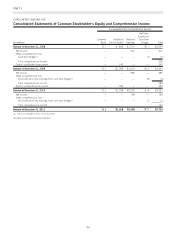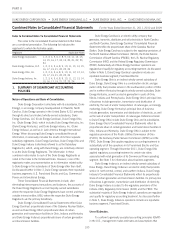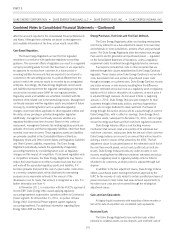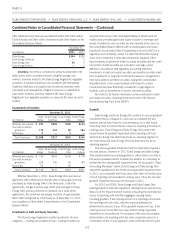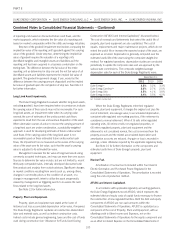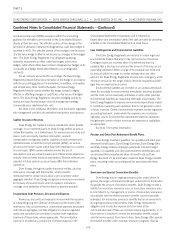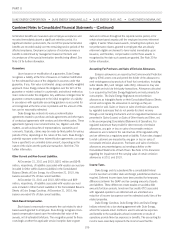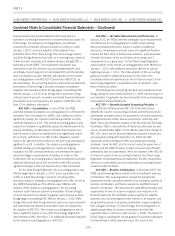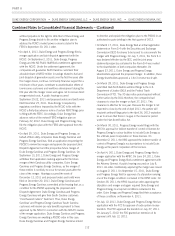Duke Energy 2011 Annual Report Download - page 125
Download and view the complete annual report
Please find page 125 of the 2011 Duke Energy annual report below. You can navigate through the pages in the report by either clicking on the pages listed below, or by using the keyword search tool below to find specific information within the annual report.
PART II
DUKE ENERGY CORPORATION •DUKE ENERGY CAROLINAS, LLC •DUKE ENERGY OHIO, INC. •DUKE ENERGY INDIANA, INC.
Combined Notes to Consolidated Financial Statements – (Continued)
purchase/normal sale (NPNS) exception within the accounting
guidance for derivatives are recorded on the Consolidated Balance
Sheetsattheirfairvalue.Theeffectiveportionofthechangeinthe
fair value of derivative instruments designated as cash flow hedges is
recorded in AOCI. The effective portion of the change in the fair value
of a fair value hedge is offset in net income by changes in the hedged
item. The Duke Energy Registrants may designate qualifying
derivative instruments as either cash flow hedges or fair value
hedges, while others either have not been designated as hedges or do
not qualify as a hedge (hereinafter referred to as undesignated
contracts).
For all contracts accounted for as a hedge, the Duke Energy
Registrants prepare formal documentation of the hedge in accordance
with the accounting guidance for derivatives. In addition, at inception
and at least every three months thereafter, the Duke Energy
Registrants formally assess whether the hedge contract is highly
effective in offsetting changes in cash flows or fair values of hedged
items. The Duke Energy Registrants document hedging activity by
transaction type (futures/swaps) and risk management strategy
(commodity price risk/interest rate risk).
See Note 14 for additional information and disclosures regarding
risk management activities and derivative transactions and balances.
Captive Insurance Reserves.
Duke Energy has captive insurance subsidiaries which provide
coverage, on an indemnity basis, to Duke Energy entities as well as
certain third parties, on a limited basis, for various business risks and
losses, such as property, business interruption, workers’
compensation and general liability. Liabilities include provisions for
estimated losses incurred but not yet reported (IBNR), as well as
provisions for known claims which have been estimated on a claims-
incurred basis. IBNR reserve estimates involve the use of
assumptions and are primarily based upon historical loss experience,
industry data and other actuarial assumptions. Reserve estimates are
adjusted in future periods as actual losses differ from historical
experience.
Duke Energy, through its captive insurance entities, also has
reinsurance coverage with third parties, which provides
reimbursement for certain losses above a per occurrence and/or
aggregate retention. Duke Energy recognizes a reinsurance receivable
for recovery of incurred losses under its captive’s reinsurance
coverage once realization of the receivable is deemed probable.
Unamortized Debt Premium, Discount and Expense.
Premiums, discounts and expenses incurred with the issuance
of outstanding long-term debt are amortized over the terms of the
debt issues. Any call premiums or unamortized expenses associated
with refinancing higher-cost debt obligations to finance regulated
assets and operations are amortized consistent with regulatory
treatment of those items, where appropriate. The amortization
expense is recorded as a component of interest expense in the
Consolidated Statements of Operations and is reflected as
Depreciation and amortization within Net cash provided by operating
activities on the Consolidated Statements of Cash Flows.
Loss Contingencies and Environmental Liabilities.
The Duke Energy Registrants are involved in certain legal and
environmental matters that arise in the normal course of business.
Contingent losses are recorded when it is determined that it is
probable that a loss has occurred and the amount of the loss can be
reasonably estimated. When a range of the probable loss exists and
no amount within the range is a better estimate than any other
amount, the Duke Energy Registrants record a loss contingency at the
minimum amount in the range. Unless otherwise required by GAAP,
legal fees are expensed as incurred.
Environmental liabilities are recorded on an undiscounted basis
when the necessity for environmental remediation becomes probable
and the costs can be reasonably estimated, or when other potential
environmental liabilities are reasonably estimable and probable. The
Duke Energy Registrants expense environmental expenditures related
to conditions caused by past operations that do not generate current
or future revenues. Certain environmental expenses receive regulatory
accounting treatment, under which the expenses are recorded as
regulatory assets. Environmental expenditures related to operations
that generate current or future revenues are expensed or capitalized,
as appropriate.
SeeNote5forfurtherinformation.
Pension and Other Post-Retirement Benefit Plans.
Duke Energy maintains qualified, non-qualified and other post-
retirement benefit plans. Duke Energy Carolinas, Duke Energy Ohio
and Duke Energy Indiana employees participate in Duke Energy’s
qualified, non-qualified and other post-retirement benefit plans and
are allocated their proportionate share of benefit costs by Duke
Energy. See Note 21 for information related to Duke Energy’s benefit
plans, including certain accounting policies associated with these
plans.
Severance and Special Termination Benefits.
Duke Energy has an ongoing severance plan under which, in
general, the longer a terminated employee worked prior to termination
the greater the amount of severance benefits. Duke Energy records a
liability for involuntary severance once an involuntary severance plan
is committed to by management, or sooner, if involuntary severances
are probable and the related severance benefits can be reasonably
estimated. For involuntary severance benefits that are incremental to
its ongoing severance plan benefits, Duke Energy measures the
obligation and records the expense at its fair value at the
communication date if there are no future service requirements, or, if
future service is required to receive the termination benefit, ratably
over the service period. From time to time, Duke Energy offers special
termination benefits under voluntary severance programs. Special
105






